Architect, town planner, sculptor, painter, furniture designer… In 1925 Le Corbusier declared that the terms house, interior decoration, and armchair were to be replaced by "machine for living in", "house equipment", and "machine for sitting in." More than a mere shift in vocabulary, this was a direct challenge to accepted approaches to housing and furniture.
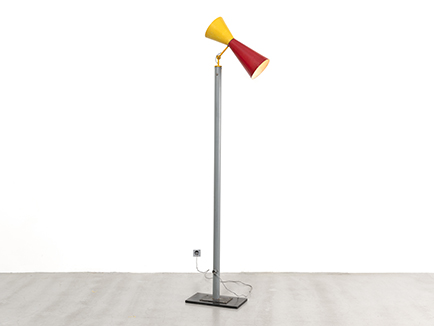
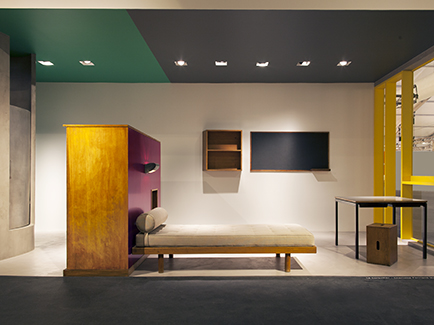
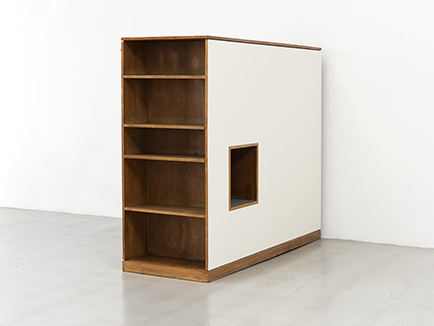
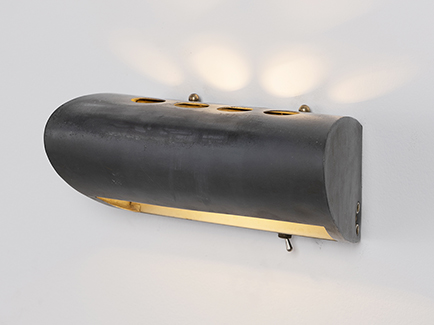
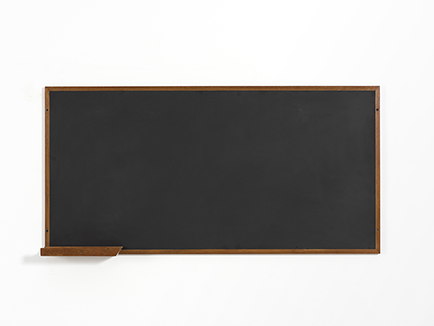
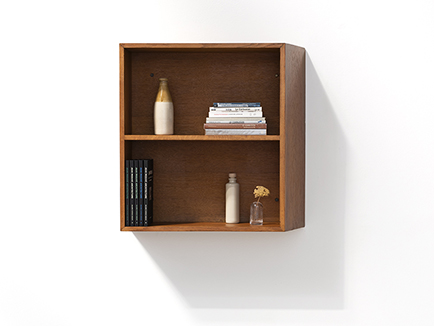
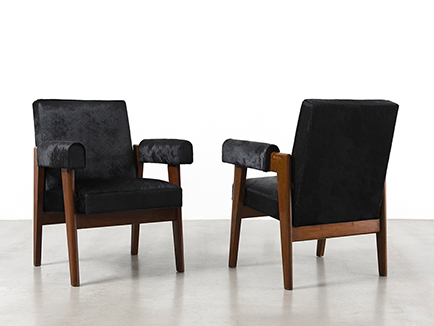
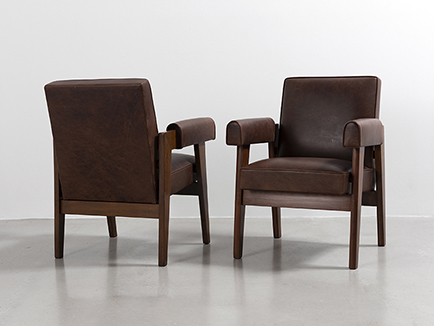
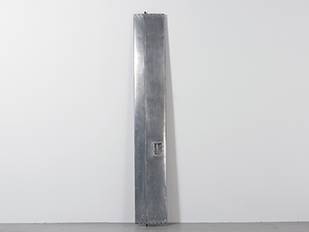
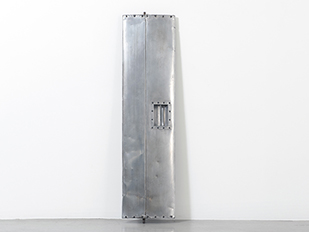
LE CORBUSIER
1887
6 October: birth in La Chaux-de-Fonds of Charles-Édouard Jeanneret, son of Georges-Édouard Jeanneret, watch engraver and enameler, and Marie Charlotte Amélie Jeanneret-Perret, musician.
1904
Begins studies in interior design under Charles L’Eplattenier, who interests him in architecture.
1905
Commissioned by Louis Fallet to build a house in La Chaux-de-Fonds, in association with architect René Chapallaz.
1907
In September he leaves for two and half months in Italy: Milan, Florence, Venice and elsewhere. November: travels to Vienna via Budapest. Spends four months in Vienna: draws up plans for the Stotzer and Jacquemet houses in La Chaux-de-Fonds.
1908
In Vienna he meets Josef Hoffmann and the artists Moser and Klimt. March: travels to Paris via Nuremberg, Munich, Strasbourg, and Nancy.
Meets Tony Garnier in Lyon. In Paris he visits Jourdain, Plumet, Sauvage, and Grasset. Begins working for Auguste and Gustave Perret as a part-time draftsman.
1909
Fall: returns to La Chaux-de-Fonds for the building of the Stotzer and Jacquemet houses.
1910
Founding of the Ateliers d’Arts Réunis pour L’Amélioration de l’Art (United Studios for the Improvement of Art). April: after a study trip to Germany he will publish A Study of the Decorative Art Movement in Germany in 1912. Winter: works for five months in Peter Behrens’ architecture practice in Berlin. Meets Ludwig Mies Van der Rohe and Walter Gropius.
1911
He meets Heinrich Tessenow, architect of the garden city of Hellerau. May: with his friend and art history student Auguste Klipstein he leaves Dresden for Prague, Vienna, Budapest, Belgrade, Bucharest, Tarnovo, Gabrovo, Kasanlik, Istanbul, Mount Athos (a 21-day stay), Athens and Southern Italy. The trip results in numerous drawings and sketches, six full notebooks, and several hundred photographs. Writes articles excerpted from his notebooks for the Chaux-de-Fonds magazine La Feuille d’avis. October: returns to La Chaux-de-Fonds to set up a new section of the art school with Charles L’Eplattenier.
1912
Builds Villa Jeanneret-Perret in La Chaux-de-Fonds and Villa Favre-Jacot at Le Locle.
1913
First exhibition: The Language of Stones, ten watercolors at the Salon d’Automne in Paris.
1914
Goes to Cologne for the Werkbund exhibition. Preliminary studies for his Dom-Ino house.
1915
Works on the manuscript of La construction des villes.
1916
Builds the Schwob house (known as “Villa Turque”) and the La Scala cinema in La Chaux-de-Fonds.
1917
Leaves La Chaux-de-Fonds definitively. Paris: opens his first architecture studio at 20 Rue de Belzunce, then at 29 Rue d’Astorg. Lives at 20 Rue Jacob until 1933.
1918
Through Auguste Perret he meets painter Amédée Ozenfant and other artists including Braque, Juan Gris, Picasso, and Lipchitz. First painting: The Fireplace. “Purist” exhibition with Ozenfant at Galerie Thomas in Paris.
1919
Starts the magazine L’Esprit nouveau with Ozenfant and Paul Dermée.
1920
Meets Fernand Léger. Begins calling himself Le Corbusier, a name borrowed from an Albigensian ancestor.
1921
He and Ozenfant buy Cubist pictures for Raoul La Roche at the Kahnweiler sale. Exhibits at Galerie Druet. Travels to Rome with Ozenfant.
1922
Begins his partnership with his cousin, Pierre Jeanneret. Gives his first lecture at the Sorbonne. Meets Monaco model Yvonne Gallis, whom he will marry in1930. Shows the plans for his Contemporary City of Three Million People at the Salon d’Automne. Builds Villa Besnus at Vaucresson and Ozenfant’s house/studio in Paris. Works on various projects: the Citrohan house, villa-blocks, etc.
1923
Publishes Towards a New Architecture. Exhibition Jeanneret-Ozenfant at Léonce Rosenberg’s L’Effort Moderne gallery. Builds the La Roche and Jeanneret houses in Paris and Auteuil and Le Lac (“The Little House”) in Corseaux.
1924
Moves his practice to 35 Rue de Sèvres, Paris 6. Lectures in Geneva, Lausanne, and Prague. Publishes Urbanisme.
Builds workers’ houses in Lège, near Bordeaux and
Lipchitz-Miestchaninoff houses in Boulogne-sur-Seine.
1925
Publishes The Decorative Art of Today, Almanach d’architecture moderne, and La Peinture moderne (with Ozenfant).
Builds the Pavillon de L’Esprit nouveau in Paris and the Frugès housing estate in Pessac. Works on his Plan Voisin for Paris and the Meyer house.
1926
11 April: death of his father, Georges-Édouard Jeanneret. Publishes Architecture d’époque machiniste. Builds Villa Cook (Boulogne-sur-Seine), the Guiette house (Antwerp), the Ternisien house (Boulogne-sur-Seine) and the Salvation Army People’s Palace in Paris.
1927
Lectures in Madrid, Barcelona (where he visits buildings by Antoni Gaudí), Brussels, and Frankfurt. Enters the competition for the League of Nations building in Geneva. Is awarded equal first prize, but his project is turned down. Builds Villa Stein-de-Monzie (Garches), the Planeix house (Paris) and houses in Weissenhof (Stuttgart).
1928
Helps found the CIAM (International Congresses for International Architecture) in La Sarraz, Switzerland. Publishes Une Maison – Un Palais (A House – A Palace). Lectures in Prague and Moscow. Builds Villa Baizeau (Carthage, Tunisia), Villa Church (Ville d’Avray), and exhibition pavilions for Nestlé (Paris) and Centrosoyus (Moscow).
1929
Travels in South America. A series of ten lectures in Buenos Aires, Montevideo, Rio de Janeiro and São Paolo. He shows furniture at the Salon d’Automne, together with Charlotte Perriand and Pierre Jeanneret. 2nd CIAM congress in Frankfurt. Builds Villa Savoye (Poissy), works on the Mundaneum knowledge center and town planning in South America.
1930
Takes out French Nationality. 18 December: marries Yvonne Gallis. Trip to Moscow (meets Meyerhold, Tairov, and Eisenstein). Travels in Spain with Fernand Léger and Pierre and Albert Jeanneret. 3rd CIAM congress in Brussels. Publishes Precisions: On the Present State of Architecture and City Planning. Works for the magazine Plans. Builds the Beistegui apartment (Paris), Villa de Mandrot (Le Pradet), the Clarté apartment block (Geneva) and the Swiss pavilion at the Cité Universitaire in Paris. Town planning projects for Algiers, studies for the “Ville Radieuse” and for the Palace of the Soviets in Moscow.
1931
Travels in Spain with Pierre Jeanneret, then continues on to Morocco and Algeria. Visits the MZab in the northern Sahara. Builds an apartment block on Rue Nungesser-et-Coli (Boulogne-sur-Seine).
1932
Enters the preliminary competition for the International Exhibition of Art and Technology in Modern Life, scheduled for Paris in 1937.
Lectures in Stockholm, Oslo, Gothenberg, Antwerp, Algiers, Barcelona.
1933
Honorary doctorate from the University of Zurich. 4th CIAM congress in Athens. Contributes to the Athens Charter.
1934
Moves into his apartment-studio-terrace on the 8th floor of 24 Rue Nungesser-et-Coli (Boulogne-sur-Seine). Lectures in Rome, Milan, Algiers, Barcelona. Frequent trips to Algiers.
1935
Publishes Aircraft and The Radiant City. At the invitation of MoMA in New York, he lectures in Boston, Chicago, Philadelphia, Madison, Hartford and other cities. Trip to Zlin in Czechoslovakia for a town planning project. Meets Joseph Savina. Louis Carré presents an exhibition of primitive art in Le Corbusier’s apartment. Builds the weekend house at La Celle-Saint-Cloud and the villa Le Sextant at Les Mathes.
1936
Second trip to South America, aboard the Graf-Zeppelin. Lectures in Rio. Studies for a 100,000-seat stadium in Paris. Paints a mural in the home of his friend Jean Badovici in Vézelay. First tapestry for Marie Cuttoli.
1937
Is made a Knight of the Legion of Honor. Honorary member of the Royal Institute of British Architects (RIBA). 5th CIAM congress in Paris Publishes When the Cathedrals Were White. Works on his plan of Paris and his Cartesian apartment block. Builds the Pavillon des Temps Nouveaux at the International Exhibition in Paris.
1938
Shows his paintings at the Zurich Kunsthaus and Galerie Louis Carré in Paris. Publishes Des canons, des munitions? Merci! Des logis s.v.p. (Guns and ammunition? No thanks! Give us housing please) and L’Ilôt insalubre nº 6. (Unsanitary Zone no. 6). Paints eight frescoes in Villa E-1027, the home of Eileen Gray and Jean Badovici at Roquebrune-Cap-Martin.
1939
Meets Jean Giraudoux at the launch of the Committee for Preparatory Urban Studies (CEPU). Awarded an honorary degree by the Royal Academy of Fine Arts in Stockholm. Publishes “Le Lyrisme des Temps nouveaux” and “L’Urbanisme” in the magazine Le Point.
1940
11 June: he shuts down the studio at 35 Rue de Sèvres and leaves for Ozon in the Pyrenees with his wife and Pierre Jeanneret.
1941
Long stay in Vichy. Publishes Destin de Paris and Sur les quatre routes.
1942
Founds ASCORAL (Constructors United for a Regenerated Architecture). Official trip to Algiers. Reopens the Rue de Sèvres studio.
Publishes La Maison des Hommes with François de Pierrefeu and Les Constructions Murondins.
1943
Begins working with Joseph Savina. Publishes Entretiens avec les étudiants des écoles d’architecture and The Athens Charter.
1944
Research on the Unités d’habitation.
1945
Founds ATBAT (The Builders’ Studio). Meets Eugène Claudius-Petit, future minister of Reconstruction and Town Planning. Leaves for New York aboard the liberty ship Vernon S. Hood: works on the Modulor with Gerald Hanning. Publication of The Three Human Establishements.
1946
Visits Princeton University. Meets Albert Einstein. Publishes Concerning Town Planning.
1947
Consultant for the committee organizing the building of the United Nations headquarters in New York. 6th CIAM congress in Bridgewater.
Publishes U.N. Headquarters. Builds the Claude & Duval factory (Saint-Dié) and lays the first stone for the Unité d’Habitation in Marseille.
1948
A number of exhibitions in the United States: at the Paul Rosenberg Gallery in New York and the Institute of Contemporary Art in Boston, then Detroit, San Francisco, Colorado Springs, Cleveland and other cities. Begins working on tapestries with Pierre Baudouin. Paints a mural for the Swiss pavilion at the Cité Universitaire in Paris. Paints a mural in the Rue de Sèvres studio at the request of his staff.
1949
Signs a contract with the Colombian authorities for a town-planning study for Bogotá. 7th CIAM congress in Bergamo. Builds Villa Curutchet in La Plata, Argentina. Visits the Unité d’Habitation in Marseille with Picasso.
1950
First sketches for the chapel at Ronchamp. Is made a consultant for the Punjab government and the creation of its new capital, with Pierre Jeanneret, Maxwell Fry and Jane Drew. Publishes Modulor I, Poésie sur Alger and The Marseilles Block. Builds his Cabanon at Roquebrune-Cap-Martin, his habitual summer retreat.
1951
18 February: first trip to India. Visits Chandigarh and Ahmedabad. 8th CIAM conference in Hoddesdon. Lectures in Bogotá. Spends time in New York and works with Constantino Nivola on sand sculptures and murals. His proposal for the UNESCO headquarters in Paris is turned
down. Exhibits at MoMA, New York. Presentation of his Open Hand monument in Chandigarh. Builds the Notre-Dame-du-Haut chapel (Ronchamp), the Shodan and Sarabhai villas (Ahmedabad), the Museum (Ahmedabad), and the Mill Owners’ Association building
(Ahmedabad). November: second trip to India. Begins planning his projects for Chandigarh: Legislative Assembly, High Court, Governor’s Residence, Secretariat, Museum. Lectures at the Milan Triennial.
1952
Is made a Commander of the Legion of Honor. March: third trip to India. 14 October: official opening of the Unité d’Habitation
in Marseille. Builds the Jaoul houses (Neuilly-sur-Seine) and a Unité d’Habitation (Rezé-les-Nantes).
1953
Appointed to the five-member supervision committee for the UNESCO project in Paris, with Gropius, Breuer, Markelius and Rogers. 9th CIAM congress in Aix-en-Provence. Exhibits at the Musée d’Art Moderne in Paris. Builds the Sainte-Marie de la Tourette priory (Eveux).
1954
November: goes to Japan for the Museum of Western Art project in Tokyo.
1955
Receives an honorary doctorate from the Ecole Polytechnique Fédérale in Zurich. Official opening of the chapel at Ronchamp and the Unité d’Habitation in Rezé. Trip to Chandigarh for the opening of the High Court by Nehru. Publishes The Poem of the Right Angle, Modulor 2, and L’Architecture du bonheur – L’urbanisme est une clef.
1956
He turns down a teaching post at the Ecole des Beaux-arts in Paris.
1957
5 October: death of his wife Yvonne. “Ten Cities”: a major retrospective curated by Willy Boesiger in Zurich, Berlin, Munich, Frankfurt, Vienna, The Hague, Paris, etc. Exhibits in the art museum in La Chaux-de-Fonds.Is made an honorary citizen of La Chaux-de-Fonds. Member of the Royal Academy of Fine Arts in Copenhagen. Commander of Arts and Letters (France). Publishes Von der Poesie des Bauens and Ronchamp. Buildings: Unité d’Habitation (Berlin), Brazil pavilion at the Cité Universitaire (Paris) with Lucio Costa, Unité d’Habitation (Briey-en-Forêt) and the Museum of Western Art (Tokyo).
1958
Trip to the United States. Builds the Philips Pavilion at the World’s Fair in Brussels. Awarded an honorary diploma by the World’s Fair for the Philips Pavilion. Designs Le Poème électronique to a score by Edgar Varèse. Official opening of the Secretariat in Chandigarh.
1959
Honorary doctorate at the University of Cambridge. International campaign for the protection of Villa Savoye as a Historic Monument. Trips to India. Builds the Cultural Center in Firminy (France). Eugène Claudius-Petit commissions the Unité d’Habitation in Firminy-Vert. Release of the second Salubra color keyboard.
1960
15 February: death of Le Corbusier’s mother. 19 October: official opening of the Sainte-Marie de la Tourette priory. Publication of Creation is a Patient Search. Builds the Kembs-Niffer lock on the Grand Alsace Canal.
1961
Commander of the Order of Merit. Honorary doctorate from the University of Colombia. Gold medal from the American Institute of Architects. Frequent trips to Firminy. Studies for the church of Saint Pierre. Seven sketches for tapestries for the High Court in Chandigarh.
Exhibitions in Zurich and Stockholm. Trips to India. Builds the Carpenter Center for the Visual Arts at Harvard University.
1962
Trip to Brazil for the French Embassy in Brasilia. Retrospective exhibition at the Musée d’Art Moderne in Paris. Official opening of the Legislative Assembly in Chandigarh. Builds the Unité d’Habitation in Firminy.
1963
Gold medal from the City of Florence. Grand Officer of the Legion of Honor. Honorary doctorate from the University of Geneva. Official opening of the Carpenter Center for the Visual Arts. Exhibits at Palazzo Strozzi in Florence. Builds the Le Corbusier Center in Zurich for Heidi Weber. June: is awarded the Grand Cross of the Legion of Honor by André Malraux in the studio at 35 Rue de Sèvres.
Commission for the hospital in Venice. Exhibits in Zurich and La Chaux-de-Fonds.
1965
Revises his study for the Open Hand monument in Chandigarh. Honorary diploma from the Boston Architectural Society. Publishes Texts and Sketches for Ronchamp. Builds the stadium in Firminy. 27 August: Le Corbusier dies while swimming off Cap-Martin in the Mediterranean. Official funeral in the Cour Carré at the Louvre. Le Corbusier is buried in the cemetery at Cap-Martin.